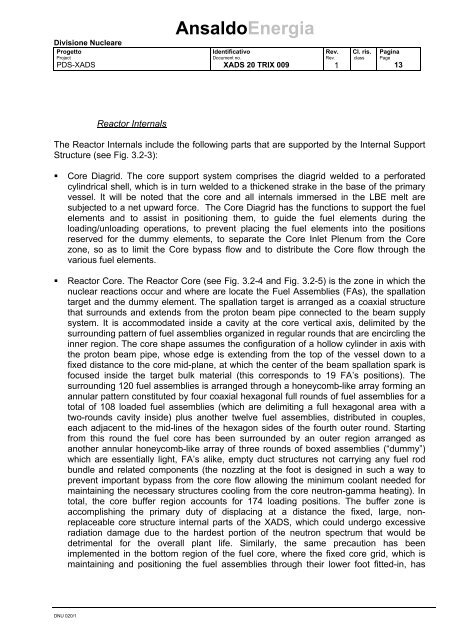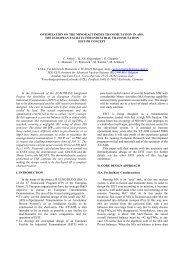AnsaldoEnergia
AnsaldoEnergia - KIT
AnsaldoEnergia - KIT
- No tags were found...
You also want an ePaper? Increase the reach of your titles
YUMPU automatically turns print PDFs into web optimized ePapers that Google loves.
Divisione Nucleare<br />
Progetto<br />
Project<br />
PDS-XADS<br />
<strong>AnsaldoEnergia</strong><br />
Identificativo<br />
Document no.<br />
XADS 20 TRIX 009<br />
Rev.<br />
Rev.<br />
1<br />
Cl. ris.<br />
class<br />
Pagina<br />
Page<br />
13<br />
Reactor Internals<br />
The Reactor Internals include the following parts that are supported by the Internal Support<br />
Structure (see Fig. 3.2-3):<br />
• Core Diagrid. The core support system comprises the diagrid welded to a perforated<br />
cylindrical shell, which is in turn welded to a thickened strake in the base of the primary<br />
vessel. It will be noted that the core and all internals immersed in the LBE melt are<br />
subjected to a net upward force. The Core Diagrid has the functions to support the fuel<br />
elements and to assist in positioning them, to guide the fuel elements during the<br />
loading/unloading operations, to prevent placing the fuel elements into the positions<br />
reserved for the dummy elements, to separate the Core Inlet Plenum from the Core<br />
zone, so as to limit the Core bypass flow and to distribute the Core flow through the<br />
various fuel elements.<br />
• Reactor Core. The Reactor Core (see Fig. 3.2-4 and Fig. 3.2-5) is the zone in which the<br />
nuclear reactions occur and where are locate the Fuel Assemblies (FAs), the spallation<br />
target and the dummy element. The spallation target is arranged as a coaxial structure<br />
that surrounds and extends from the proton beam pipe connected to the beam supply<br />
system. It is accommodated inside a cavity at the core vertical axis, delimited by the<br />
surrounding pattern of fuel assemblies organized in regular rounds that are encircling the<br />
inner region. The core shape assumes the configuration of a hollow cylinder in axis with<br />
the proton beam pipe, whose edge is extending from the top of the vessel down to a<br />
fixed distance to the core mid-plane, at which the center of the beam spallation spark is<br />
focused inside the target bulk material (this corresponds to 19 FA’s positions). The<br />
surrounding 120 fuel assemblies is arranged through a honeycomb-like array forming an<br />
annular pattern constituted by four coaxial hexagonal full rounds of fuel assemblies for a<br />
total of 108 loaded fuel assemblies (which are delimiting a full hexagonal area with a<br />
two-rounds cavity inside) plus another twelve fuel assemblies, distributed in couples,<br />
each adjacent to the mid-lines of the hexagon sides of the fourth outer round. Starting<br />
from this round the fuel core has been surrounded by an outer region arranged as<br />
another annular honeycomb-like array of three rounds of boxed assemblies (“dummy”)<br />
which are essentially light, FA’s alike, empty duct structures not carrying any fuel rod<br />
bundle and related components (the nozzling at the foot is designed in such a way to<br />
prevent important bypass from the core flow allowing the minimum coolant needed for<br />
maintaining the necessary structures cooling from the core neutron-gamma heating). In<br />
total, the core buffer region accounts for 174 loading positions. The buffer zone is<br />
accomplishing the primary duty of displacing at a distance the fixed, large, nonreplaceable<br />
core structure internal parts of the XADS, which could undergo excessive<br />
radiation damage due to the hardest portion of the neutron spectrum that would be<br />
detrimental for the overall plant life. Similarly, the same precaution has been<br />
implemented in the bottom region of the fuel core, where the fixed core grid, which is<br />
maintaining and positioning the fuel assemblies through their lower foot fitted-in, has<br />
DNU 020/1





